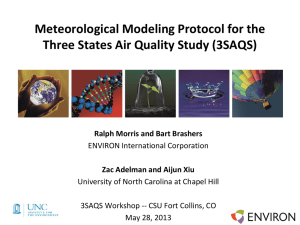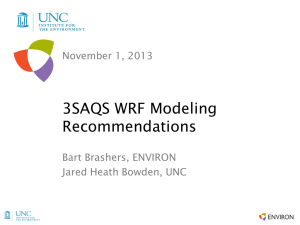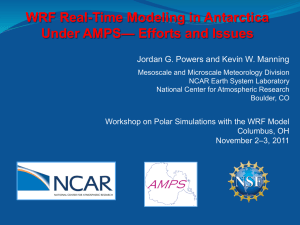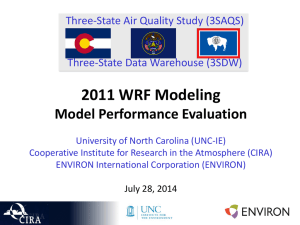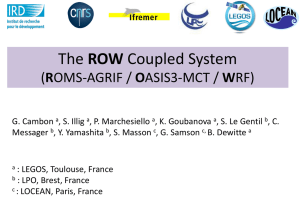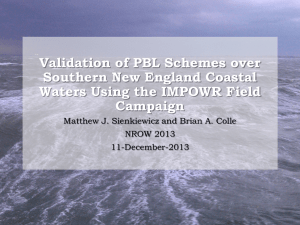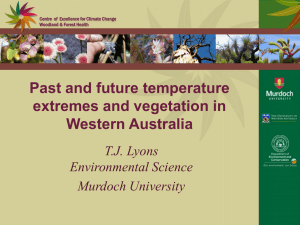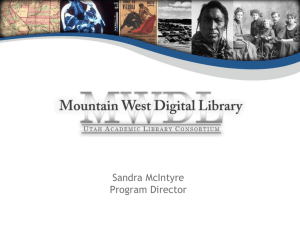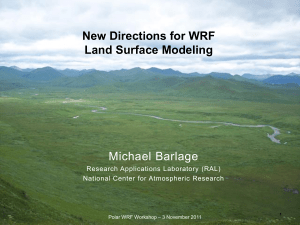lair_STILT
advertisement
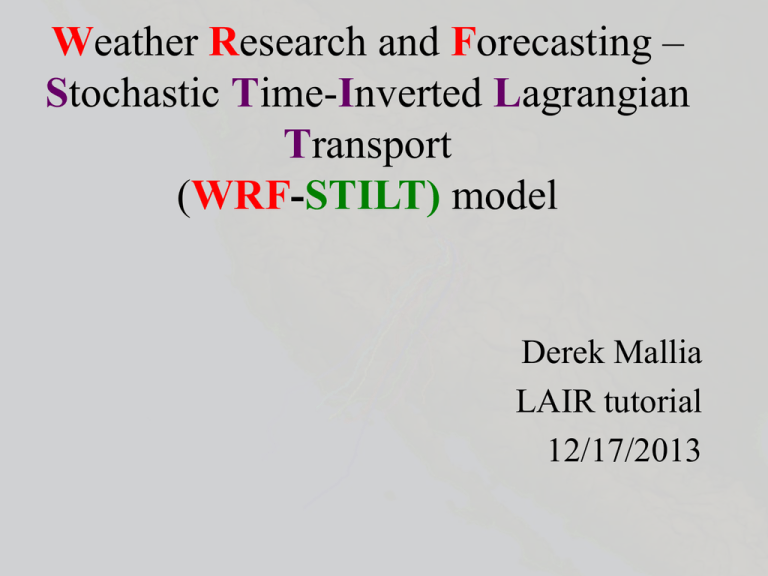
Weather Research and Forecasting – Stochastic Time-Inverted Lagrangian Transport (WRF-STILT) model Derek Mallia LAIR tutorial 12/17/2013 PART I: STILT basics Backward trajectory simulation using the WRF-STILT model for Hurricane Sandy Basics of the STILT model • The STILT model is a 4D (x,y,z,t) Lagrangian particle dispersion model (LDPM) for atmospheric transport • http://www.stilt-model.org/pmwiki/pmwiki.php • The model was primarily developed to derive upstream influence regions for some receptor that we are trying to model for • Can also be used qualitatively to determine the origin of your air mass • Driven by meteorological models/analyses such as the ECMWF, GDAS, NAM, and WRF • However, WRF output cannot be directly used with the STILT model without converting the netcdf file format to “ARL” format which is used by the HYSPLIT model core in STILT • For optimal results, 3-hourly averaged winds are required (better mass conservation) For non-WRF analyses • Go to: http://www.ready.noaa.gov/archives.php • I generally use these to get a “quick” first look • Also good for using as an outer domain • I.E if your particles leaves your outer WRF domain, you can still track them beyond that domain if you nest it with something like GDAS which is “global” • Downside of these products? • Generally, lower spatial and temporal resolution • Worse mass conservation (see Nehrkorn et at. 2010) • Not necessarily tailored to your needs GDAS domain WRF domain Uinta Basin example: In the inversion… Outside of the inversion… Relevant papers for details Lin, J.C., C. Gerbig, S.C. Wofsy, et al., A near-field tool for simulating the upstream influence of atmospheric observations: The Stochastic Time-Inverted Lagrangian Transport (STILT) model, J. Geophy. Res., 108(D16), 4493, doi:10.1029/2002JD003161, 2003. Nehrkorn, T., J. Eluszkiewicz, S.C. Wofsy, Lin, J.C., C. Gerbig, M. Longo, and S. Freitas. Coupled Weather Research and Forecasting--Stochastic TimeInverted Lagrangian Transport (WRF-STILT) Model, Meteorology and Atmospheric Physics, 107, 51-64, 2010. Cool model bro, where do I get this model? • First, need to download the STILT model from: • http://www.bgc-jena.mpg.de/bgcsystems/projects/stilt/pmwiki/pmwiki.php?n=FAQ.InitialSetupTasks • Also need to register • Better directions can be found here with FORTRAN hotfix: • • • • http://home.chpc.utah.edu/~u0703457/WRF_STILT_code/STILT Fixes random model crash… How to run guide: http://home.chpc.utah.edu/~u0703457/WRF_STILT_code/STILThowtoV8.pdf • Model uses name list file to run simular to that of WRF, however, can be ran using a “R” using the scripts provided in the stiltR directory • Makes the model less clunky to use, however it requires becoming slightly familiar with R (very easy to use) • Need help? Feel free to bug me (WBB 723) Running STILT at the FORTRAN level • For now lets just copy the hymodelc executable (has all of the necessary bug fixes) along with my modified stiltR code and meteorological input files which can be found here: • /uufs/chpc.utah.edu/common/home/lin-group2/STILT_tutorial • Now lets get familiar with running the STILT at the FORTRAN level… Two “namelist” files for STILT… See STILThowtoV8.pdf for variable descriptions Only these lines need to be modified… See STILThowtoV8.pdf formatting of this file… • Type hymodelc into you command line once we have finished editing our CONTROL file… • If the CONTROL file was properly edited you code should be running! (will take a few moments) Sample output file… Running STILT using the stiltR interface • Lets cd into the stiltR directory and get familiar with some of the most important subroutines • Once your have your bearings lets open up automatic_trajplot_WRF.r with your favorite text editor • Lets enter R now (type R into the command line within the stiltR directory and run our tutorial code GDAS d01 d02 & 3 Sample output Units: PPM / μmoles m-2 s-1 PART II: STILT advanced settings STILT model installed now what? • Need to get WRF data in ARL format and need to output specific variables that are required by the STILT model • Involves installing a converter program and editing the WRF registry + recompiling the WRF • Also had to fix some bugs as well • No worries, I supplied the ARL converter code, additional FORTRAN fixes, and easy to read instructions for WRF registry editing: http://home.chpc.utah.edu/~u0703457/WRF_STILT_code/ARL_co nverter_kingspeak/ • Directions for ARL converter code installation and running can be found here: http://home.chpc.utah.edu/~u0703457/WRF_STILT_code/ARL_C ONVERTER – Most of the starting steps can be skipped as I did this already! – Don’t bother with having more than 100 WRF vertical levels… lots of ISSUES – ZSG code can be found here (for STEP #8) :http://home.chpc.utah.edu/~u0703457/WRF_STILT_code/Elena_codes/ Additional steps… • Additional all of the files found here: • http://home.chpc.utah.edu/~u0703457/WRF_STILT_code/part_drop_fi x/ • This subroutines will need to be copy pasted into your merged_hysplit directory that was used to compile the original STILT model code • HELPFUL TIP, copy the merged_hysplit directory and make a new one which will be used to recompile STILT with the update code above • This is needed to fix some minor mass conservation issues and random particles dropping out for no reason (has to do with particle being dropped from memory as they leave the sub domains) • If you use stiltR, copy and paste Trajec.r to your stiltR directory which adds additional mgmin variable to prevent above issue • If not, additional line needs to be added to the SETUP.CFG file with the following MGMIN = 2000, Sample output… Footprints x Emissions = Footprint of emission source (mole fraction) Units: PPM / μmoles m-2 s-1 Units: micromoles / m2 s PPM /μmoles m-2 s-1 * μmoles / m2 s = PPM of stuff

